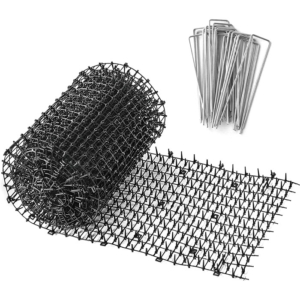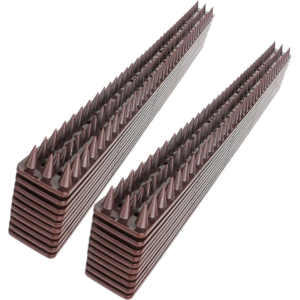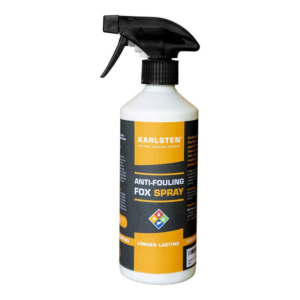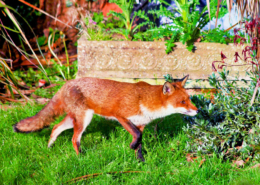The Top 10 Fox Deterrents UK
“How bad can foxes be?!” sneered a skeptical friend of mine, who, I quickly established, had never experienced foxes coming into his garden in his life.
That was shortly after I moved to South London in 2007 and encountered urban foxes for the first time. I suppose my friend’s reaction was understandable. It’s not until you encounter foxes on a regular basis that you realise just how destructive their behaviour can be.
And, as this FRE reader found out, foxes can be really destructive:
“We have a fox intent on eating the emissions sensor on our 4X4 vehicle that is a month old. So far it has cost £700 to replace the part and within a week of repair, the cable had been chewed through again! Help!“
Jane, Hampshire
Not that getting irritated by chewed wiring, flattened flowers, pooped-on patios or dug-up lawns means that we wish any harm to foxes.
On the contrary, most of us simply want to find a humane way of stopping foxes doing the things that annoy us, without resorting to extreme measures.
“I am so deeply grateful for your help. My poor cat is terrified to go out, but an angry neighbour has threatened to have the ‘orange hell beast’ shot! I would hate to see the cheeky b*stard murdered since it’s only doing what’s in its nature“
Moya, London
Calling out a pest control specialist is expensive and needlessly causes the death of an innocent animal. It also doesn’t sort out the issue for very long, as a neighbouring fox will quickly realise the territory is vacant and move in.
We want to be humane and we want to solve the problem. So what fox deterrents should we use to reclaim our garden and make it a fox-free zone?
Beware of unhelpful advice
Finding good quality information proved to be more difficult than I thought when I first started tackling the foxes in our garden. I spent hours searching online but I found the ‘advice’ was mostly a mixture of outdated information and unhelpful nastiness:
“My Grandad swears by Creosote.” Banned in 2003.
“Soak rags in Renardine.” Banned in 2005.
“Mothballs. That’ll sort it.” Banned in 2008.
“Send them back to the country where they belong.” Animal Welfare Act 2006.
“The only good fox is a dead fox. Use a 6 bore.” This isn’t the 19th Century.
“Just wee in your garden.” It’s to repel foxes, Constable.
In all, I wasted about two years and a small fortune trying to find the ‘magic bullet’ (excuse the pun) that would rid foxes from my garden for good. Needless to say I didn’t find it.
I was inconsistent in my efforts, I didn’t have a clear strategy and, to be honest, I didn’t really know what I was doing. Consequently, foxes were still pooing on the patio, digging under the decking and destroying the daffodils.
The major turning point came when I picked up the excellent book, ‘‘Urban Foxes’ by Professor Stephen Harris [aff], head of the Mammal Research Unit at the University of Bristol. That book taught me more about foxes in two hours than the unsuccessful battle in my garden had taught me in two years.
Armed with actual knowledge of how foxes think and behave, I was able to formulate a successful strategy which led to me converting my garden from being completely overrun into a foxy Fort Knox.
And what was the single most important piece of information that transformed my success with stopping my fox problems? It was surprisingly simple.
Foxes don’t like feeling confused, disrupted or vulnerable.
Therefore, in order to successfully deter foxes, your garden needs to make them feel unwelcome and somewhere they don’t want to hang around for long. If a fox senses potential confrontation, they would rather retreat to a place of safety than face a situation that risks injury or even death.
So, what can you do to your garden to make a fox feel uncomfortable and vulnerable?
The 3-step fox deterrent strategy
STEP 1 – LOCATE THE FOX’S ENTRY POINT
Working out where a fox comes into your garden is one of the biggest tactical advantages you can have in the battle to keep foxes away on a long-term basis. This is because the entry point is where the fox decides whether or not it’s safe to enter your garden.
If the entrance looks, sounds and smells safe, the fox will decide, ‘Yes, all seems fine. I’m going in.‘ This is probably how the fox views your garden at the moment and likely has done for a long time.
But if you locate the entry point and made it look, sound or smell unsafe through the use of fox deterrents, the fox will think ‘No, this doesn’t feel right. I better move on.‘
Creating doubt and suspicion at the entry point ensures the fox’s sensory alarms are triggered immediately, before it has even set foot in your garden.
You’ll be nipping the issue in the bud, putting the fox off before it gets the chance to foul, dig or cause any other problems that you’ve been experiencing.
Once you’ve located the entry point, (which shouldn’t be too difficult – foxes will almost always enter in the same place), you should try to make this spot as unwelcoming as possible.
STEP 2 – USE MULTIPLE DETERRENTS
To make it very clear that foxes are not welcome in your garden, it’s worth using at least two different fox deterrents. It’s important these two deterrents target different senses from one another.
For example, if you use two scent-based deterrents, both products will put a fox on alert via its sense of smell. There’s nothing wrong with that and it’s much better than doing nothing.
However, if you add an ultrasonic device into the mix and use it along with a scent-based deterrent, the fox will be alerted via its sense of hearing and via its sense of smell. Danger signals to two senses rather than only one.
If two separate instincts are warning a fox there’s potential danger in your garden, you’ll have much more success in convincing it your garden is too high-risk to proceed into.
STEP 3 – BE PATIENT AND PERSISTENT
One traffic jam wouldn’t make us stop using our preferred route to work. But repeated traffic jams, every single time, would eventually cause us to consider taking alternative roads to get there.
A fox works the same way. Your garden is part of its route as it does the rounds of its territory and this won’t change unless you give it a reason to think otherwise. However, also just like us, the fox is unlikely to instantly change its habits after a solitary bad experience. Instead, it takes multiple negative encounters for the fox to realise your garden is not the relaxing environment it once was.
If you only use a fox deterrent once, the fox will quickly realise it was just a one-off inconvenience and will soon be back to invade your garden as normal. But use a fox deterrent repeatedly and the fox will begin to learn that the disruption is permanent.
Deterring foxes successfully is not an exact science, nor is it something that happens overnight – they are wild animals after all and won’t suddenly change their behaviour just because you’ve had enough of them.
But with patience and persistence you’ll force the fox to re-evaluate your garden and consider it as a place that is irritating, risky and unpredictable. This change of attitude is ultimately what is required to reduce or even stop the problems that have been driving you mad!
“I know and understand that whilst, for me, these wonderful animals are a consistent source of joy, for others, they can be a ‘nuisance’.“
Chris Packham
THE UK’S TOP 10 FOX DETERRENT LIST
Now you know a bit more about foxes and you’ve got a strategy to deter them, it’s time to take action and try some fox deterrent products in your garden.
Each deterrent in this list is the best of its type. No two are exactly the same and they all work in slightly different ways from one another, targeting different senses (sight, hearing, smell, touch etc…) and different types of problems. Hopefully there’s something here that you feel you can make use of.
It’s recommended that you use more than one type of fox deterrent because this means the fox will always have two or more of its senses instinctively warning it about the area – and foxes place great trust in their instincts telling them whether to proceed or retreat.
All the best with getting some positive results with the foxes in your garden!
Some of the products below contain affiliate links, which means this site may receive a small commission (at no extra cost to you) if you decide to make a purchase. Many thanks for using these links as it helps to keep this site running!
- In the USA or Canada? See The Top 10 Fox Deterrents USA
- In Germany, Austria or Switzerland? See Die 10 besten Mittel zur Fuchsvergrämung
1. The FoxWatch Ultrasonic Fox Deterrent
An effective device that humanely deters foxes from gardens using high-pitched sounds.
£69.95
The FOXWatch contains an infrared sensor that detects a fox’s movement and body heat to emit sharp bursts of ultrasonic noise until the fox leaves the protected garden or area.
This unit is so effective at reducing the pooing, digging and damage caused by foxes because it forces them to change their behaviour and associate your garden with the irritating noise, which ultimately keeps them away.
The FOXWatch is a very popular fox deterrent because it’s so easy to set up, with no ongoing maintenance. You simply position it in your garden, connect it to the mains adapter or a 9 Volt battery and switch it on.
✔ Pros
- Protects a large area of up to 125sqm (1350sqft)
- Provides long-term, 24/7 fox protection
- Easy to set up
- Very low maintenance
- Safe for pets and wildlife
- Made in UK, tested on British red foxes
✘ Cons
- Higher initial expense than many other deterrents
2. Scoot Fox Repellent
A scented repellent that tricks foxes into thinking another animal has taken over the territory.
£50 RRP (400g)
The smell from Scoot Fox Repellent creates an artificial ‘scentmark’, as if from another animal trying to dominate the area. In order to avoid a possible conflict or fight, the fox will keep clear of your garden while it believes it to be occupied by another predator.
Scoot comes in 50g sachets of powder that should be mixed with water. 9 litres of water added to 50g of Scoot will cover an area of up to 16sqm (172sq ft).
The solution can be sprayed using a pressure sprayer [aff] or watering can and is suitable for use on plants, grass, flowerbeds and hard surfaces.
✔ Pros
- Easy to mix and spray around garden
- Safe for plants and animals
- Low initial purchase cost
✘ Cons
- Scent fades after heavy rainfall
- Requires repeat applications to be effective
- More hands-on than other deterrents
3. Dig Stopper Prickle Strips
Really useful rows of prickly plastic spikes that stop foxes digging in flowerbeds, potted plants and vegetable patches.
£30 RRP (4 metres)
These gridded plastic spikes come in rolls of 28cm x 200cm and are great for laying down flat on areas you want to protect from being dug up by foxes. They’re also easy to cut with scissors for use in smaller spaces or planters.
Ensure you fix the rows down with tent pegs to stop inquisitive foxes from pulling them up, as the included plastic fixing pegs are surprisingly insufficient.
The spikes aren’t so sharp that they will cause harm to foxes or other wildlife, but they’re definitely enough to make it uncomfortable for the fox to stand on them, which also stops them pooing too.
✔ Pros
- Protects open soil areas
- Still allows plants and seedlings to grow
- Easy to install
- Low purchase price
✘ Cons
- Only protects area where prickles are installed
- Doesn’t keep foxes out of gardens completely
4. Motion Activated Water Sprinkler
A garden sprinkler with a movement-detecting sensor that scares foxes by shooting out a jet of water.
£30 RRP
A water ‘scarecrow’ is a popular animal deterrent that connects to a garden hose and springs into life by spraying a jet of water every time something crosses the motion sensor.
Not only does the aggressive arc of water act as a great deterrent, so does the noise of the mechanism clicking into action. It can be quite amusing the first few times it goes off to see foxes go running for cover.
Do be aware that this responds to movement, whether it’s your pets, children or yourself, it won’t just target foxes. For this reason you may want to switch it off when you are using your garden to avoid getting a squirting!
✔ Pros
- Protects large area of up to 100 sqm (1100 sqft)
- Adjustable sensitivity settings
- Easy to set up
- Power and water efficient
✘ Cons
- Also triggered by cats, dogs and children
- Mechanism can be noisy at night
- Need to leave outdoor tap on all the time
- Easy to forget to switch back on after using your garden
5. Predator Eye Pro Animal Repeller
Flashing red night lights that deter foxes by mimicking the eyes of another predator.
£27 RRP (Pack of 2)
The Predator Eye Pro is a very simple deterrent that gives foxes the impression they are under surveillance while in your garden, making them feel uneasy and causing them to leave the area quickly.
These units are solar powered so they charge during the day, then operate at night to put off any night time visitors to your garden. You will need to use an additional deterrent for daytime use.
The unit can be propped up or wall/fence mounted and the two red flashing lights are surprisingly bright, so it’s best to place them facing away from your house so you don’t see them.
✔ Pros
- Solar powered so no batteries or electricity required
- No installation or maintenance required
- Fully waterproof
- Low purchase price
✘ Cons
- Only operates at night
- Ineffective during the day
6. Plastic Wall and Fence Spikes
Plastic rows of spikes that make it difficult for foxes to get into your garden via the tops of fences or walls.
£28 RRP (Pack of 50)
You might have a fox that enters your garden by walking along a fence or wall before jumping down onto your lawn or a flowerbed. If this is the case, you can make the route into your garden much more difficult to navigate by installing some fence spikes.
You can fix them to ledges using screws, nails or a strong adhesive to create a very uninviting obstacle course along the top of your fences and walls. Attaching them to a piece of wood to be placed on the floor where the fox jumps down is also effective. They’re easy to cut down to fit a shorter or narrower space if necessary.
Again, these spikes are not designed to cause harm, but they are firm enough to create an uncomfortable sensation in a fox’s paws.
These rows of spikes are a great way of making your garden awkward to get into. The more effort a fox has to put in, the more likely it’ll go somewhere it doesn’t have to expend so much energy.
✔ Pros
- Easy to install
- Provide an instant obstacle
- Not harmful to animals
- Fairly inexpensive purchase price
✘ Cons
- Not useful if foxes don’t get into your garden over fences, walls or flat roofs
- May only slow down, rather than completely deter, particularly persistent foxes
7. Karlsten Anti-Fouling Fox Spray
A citronella-based spray to discourage foxes from fouling and digging in specific areas of the garden.
£15 RRP
Citronella is a popular ingredient in scent-based animal repellents due to its strong, off-putting smell, but without causing any harm to wildlife or plants.
If foxes are fouling, spraying urine or digging in a particular area of your garden, then this is a very effective deterrent to get them to stop. Lawns, flowerbeds, fence posts, patios and decking are common problem points and spraying this solution on a regular basis is a simple way to deal with a small-scale problem.
If dealing with fouling, safely remove the fox poo then spray on and around the affected area. For digging, spray in the hole and on the displaced soil before replacing the dirt. In either instance, you will initially need to do this on a regular basis to ensure the persistent fox gets the message. The spray also needs to be reapplied after heavy rainfall.
This spray-based repellent is effective and well-priced, making it recommended for those with small gardens or for those with a mild fox poo or digging problem. If you have a bigger garden or quite a persistent fox issue, you would be better off using one of the other deterrents above, perhaps using this as a supplementary option when needed.
✔ Pros
- Really easy to use
- Useful for small gardens, specific areas or small-scale fox problems
- Safe for pets and plants
- Low purchase price
✘ Cons
- Less suited to large gardens or widespread fouling & digging
- Requires regular spraying to be effective
- Scent diluted by heavy rainfall
8. Outdoor / camping radio
An unusual but effective way of making foxes believe humans are in the area. Conversational stations only.
£25+ RRP
A radio might initially seem like a strange choice for a fox deterrent, conjuring up amusing images of foxes being repulsed by endless repeats of Justin Bieber on commercial radio.
However, this method was popularised by Abbotsbury Swan Sanctuary in Dorset who successfully stopped foxes disturbing their swans by installing a series of radios tuned to Radio 4. The Today Programme on Radio 4 actually did a feature on it.
Radio 4 was found to be successful because it’s a conversational station, giving the impression that humans are in the area and causing foxes to keep away. Music stations were tested but didn’t have a deterrent effect.
If you live in a highly-populated urban area, it may be unpractical and anti-social for you to have a radio on in your garden day and night. But if you have a large garden or don’t have neighbours in close proximity, you may find success with this unorthodox way of reducing your fox problems, especially with poultry.
Make sure you use a radio that is suitable for outside use, such as ones marketed as all-weather, for job/construction sites or camping radios.
✔ Pros
- Effective in large rural or semi-rural areas
- Protection for chickens or other outdoor animals
- Very low maintenance
- Extremely humane
✘ Cons
- Potential to annoy neighbours
- May be ineffective if the fox is used to human voices
9. Fox poo shampoo for dogs
A deep cleaning and deodorising shampoo for dogs who like to roll in fox poo.
£4 RRP (250ml)
Not strictly a fox ‘deterrent’, but a lifesaving fox-related product for frustrated dog owners who have to deal with the aftermath of their dog gleefully rolling in fox poo. It’s a surprisingly common problem.
There’s no concrete answer on why dogs love doing this. Best guesses are that it’s a leftover instinct from their wild pack days, either to disguise their own smell from prey or to display to other members of their pack where they’ve been. No-one’s entirely sure.
Whatever the reason, it smells awful, contains germs and needs to washed out of a dog’s fur as quickly as possible. This shampoo from Animology is specially-formulated to clean, condition and deodorise a dog’s coat while also being kind to their skin.
If your dog’s a ‘roller’, this will at least help make a disgusting job slightly less disgusting.
✔ Pros
- Very useful for this specific problem
- Easy to use and apply
- Kind to dog fur and skin
- Makes the best of a nasty job
✘ Cons
- Won’t stop foxes pooing in your garden
- Won’t discourage dogs from rolling in poo again
- Not useful to those who don’t own a dog
10. Prowling fox garden ornament
A large and realistic fox statue to serve as a decorative feature in your garden.
£190 RRP
This is a very life-like fox ornament that can potentially provide a slight visual deterrent to real-life foxes considering coming into your garden. For those who like foxes, this is a beautifully crafted statue that can sit out in your garden in all weathers.
The ‘prowling fox’ is unlikely to deter foxes on its own, as smell and sound also play a vital role when a fox assesses its surroundings, but it could help if used in conjunction with other deterrents mentioned in this list.
It’s best to consider the prowling fox a beautiful addition to the garden that may have a limited deterrent effect, rather than the complete answer to all your fox problems.
✔ Pros
- Well-crafted and lifelike
- Durable and weather resistant
- May help deter timid or less dominant foxes
✘ Cons
- Not designed as a fox deterrent
- Unlikely to deter persistent or inquisitive foxes
- Expensive purchase price
Some of the resources below may contain affiliate links, which means we receive a commission (at no extra cost to you) if you use that link to make a purchase. We appreciate your use of these links as it helps to keep this website running!
- 1. The FoxWatch Ultrasonic Deterrent
- 2. Scoot Fox Repellent [aff]
- 3. Dig Stopper Prickle Strips [aff]
- 4 Motion-activated Water Sprinkler [aff]
- 5. Predator Eye Pro Animal Repeller [aff]
- 6. Plastic Fence and Wall Spikes [aff]
- 7. Karlsten Anti-Fouling Spray [aff]
- 8. Outdoor Camping Radio [aff]
- 9. Fox Poo Dog Shampoo [aff]
- 10. Prowling Fox Garden Ornament [aff]













 Photo credit: Concept Research
Photo credit: Concept Research Photo credit: Adam Lowly | Pexels.com
Photo credit: Adam Lowly | Pexels.com
 Photo credit: John Ondreasz - Pixabay
Photo credit: John Ondreasz - Pixabay



